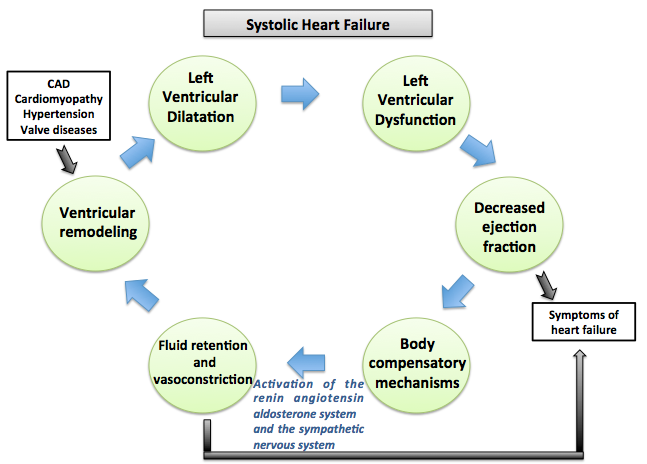Congestive heart failure chronic pharmacotherapy: Difference between revisions
Rim Halaby (talk | contribs) |
Rim Halaby (talk | contribs) No edit summary |
||
| Line 22: | Line 22: | ||
;Shown below is an image that summarizes the steps in the chronic management of patients with heart failure. | ;Shown below is an image that summarizes the steps in the chronic management of patients with heart failure. | ||
[[Image:Systolic_Heart_failure.png|center|600px|Management of chronic heart failure]] | [[Image:Systolic_Heart_failure.png|center|600px|Management of chronic heart failure]] | ||
==References== | |||
{{Reflist|2}} | |||
Revision as of 19:57, 11 November 2012
Editor-In-Chief: C. Michael Gibson, M.S., M.D. [1], Assistant editor-in-chief Rim Halaby
Overview
The chronic management of heart failure aims first to treat the symptoms of the patient and improve the exercise tolerance and quality of life. The use of diuretics and regular assessment of the patient's weight helps in avoiding excess body fluids that cause the symptoms of dyspnea and orthopnea. In addition, the treatment of heart failure also aims to decrease the rate of hospitalization and associated morbidity and mortality. Hence, all patients with heart failure should take ACE inhibitors (or ARB) and beta blockers. If the patient remained symptomatic, further management is advised.
Chronic Pharmacotherapy
The goals of the treatment of heart failure are:
- Improvement of the symptoms
- Decreased morbidity and mortality
The management of chronic heart failure includes:
- Improvement of the symptoms by the use of diuretics: In fact diuretics help in maintaining a normal fluid status and decrease pulmonary edema that causes dyspnea and orthopnea[1].
- Decrease mortality and morbidity by the use of ACE inhibitors and beta blockers[2]
- Treatment of the underlying cause of heart failure: hypertension, ischemic heart disease, valve abnormalities.
- Treatment of other non cardiac diseases that might contribute to the symptoms of heart failure like diabetes and hyperthyroidism[3].
- Diet: Low salt[4]
- Weight management to check for fluid overload
- Vaccines for influenza and pneumococcus[5].
- Shown below is an image that summarizes the steps in the chronic management of patients with heart failure.

References
- ↑ Michael Felker G (2010). "Diuretic management in heart failure". Congest Heart Fail. 16 Suppl 1: S68–72. doi:10.1111/j.1751-7133.2010.00172.x. PMID 20653715.
- ↑ Shiokawa Y (1975). "Proceedings: Streptococcus surveys in Ryukyu Islands, Japan". Jpn Circ J. 39 (2): 168–71. PMID 1117548.
- ↑ DeGroot WJ, Leonard JJ (1970). "Hyperthyroidism as a high cardiac output state". Am Heart J. 79 (2): 265–75. PMID 4903771.
- ↑ Evangelista LS, Shinnick MA (2008). "What do we know about adherence and self-care?". J Cardiovasc Nurs. 23 (3): 250–7. doi:10.1097/01.JCN.0000317428.98844.4d. PMC 2880251. PMID 18437067.
- ↑ Martins Wde A, Ribeiro MD, Oliveira LB, Barros Lda S, Jorge AC, Santos CM; et al. (2011). "Influenza and pneumococcal vaccination in heart failure: a little applied recommendation". Arq Bras Cardiol. 96 (3): 240–5. PMID 21271169.